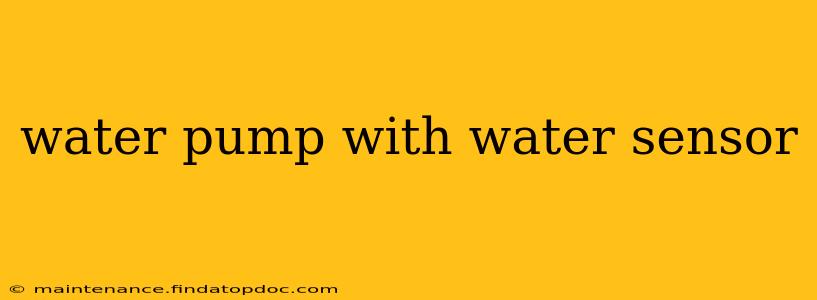Maintaining optimal hydration for your garden, lawn, or even indoor plants can be a challenge. Overwatering leads to root rot, while underwatering stunts growth. The solution? A water pump equipped with a water sensor. This smart technology automates the watering process, ensuring your plants receive just the right amount of moisture, saving you time, water, and ultimately, your plants. This guide delves into the world of water pumps with water sensors, exploring their benefits, types, and how to choose the best system for your needs.
What is a Water Pump with a Water Sensor?
A water pump with a water sensor is a sophisticated irrigation system that combines the power of a water pump with the intelligence of a moisture sensor. The sensor monitors soil moisture levels, and based on pre-set parameters, automatically activates or deactivates the pump, delivering water only when necessary. This prevents overwatering and ensures efficient water usage.
How Does a Water Pump with a Water Sensor Work?
The system typically consists of three main components:
-
Water Pump: This is the heart of the system, responsible for drawing water from a source (well, reservoir, or municipal supply) and delivering it to your plants. Different pumps cater to varying water pressures and flow rates.
-
Water Sensor (Soil Moisture Sensor): This sensor is embedded in the soil near the plant's roots. It measures the volumetric water content (VWC) – the amount of water present in the soil. Different types of sensors exist, using various technologies like capacitive, tensiometric, or resistive methods.
-
Control Unit (Often Integrated): This unit processes the data from the sensor, comparing it to the pre-programmed threshold. When the soil moisture falls below the setpoint, the control unit activates the pump, delivering water until the desired moisture level is reached.
What are the Different Types of Water Sensors Used?
Several types of water sensors are employed in these systems:
-
Capacitive Sensors: These sensors measure the dielectric constant of the soil, which changes with moisture content. They are relatively inexpensive and widely available.
-
Tensiometric Sensors: These sensors measure the soil's water tension, reflecting the water's "suction" force. They are more accurate than capacitive sensors but also more expensive.
-
Resistive Sensors: These sensors use two electrodes to measure the soil's electrical resistance, which changes with moisture content. They are simple and affordable but can be prone to inaccuracies due to soil salinity.
What are the Benefits of Using a Water Pump with a Water Sensor?
The advantages of using a smart watering system are numerous:
-
Water Conservation: By delivering water only when needed, these systems significantly reduce water waste compared to traditional watering methods.
-
Improved Plant Health: Consistent and appropriate watering promotes healthy plant growth and reduces the risk of root rot and other water-related diseases.
-
Time Savings: Automation eliminates the need for manual watering, freeing up your time and effort.
-
Cost Savings: Reduced water usage translates to lower water bills in the long run.
-
Environmental Friendliness: Water conservation contributes to responsible water resource management.
How to Choose the Right Water Pump with a Water Sensor?
Selecting the optimal system depends on several factors:
-
Water Source: Determine your water source (well, reservoir, municipal supply) to choose a pump with suitable capacity and pressure.
-
Plant Type and Size: Different plants have different water requirements. Consider the size and type of plants you are watering.
-
Soil Type: Soil type impacts sensor selection and watering frequency. Sandy soil drains faster than clay soil.
-
Budget: Prices vary significantly depending on the pump's capacity, sensor type, and features.
What are the Different Applications of Water Pumps with Water Sensors?
These systems are applicable in a wide range of settings:
-
Home Gardens: Ideal for maintaining optimal moisture levels in vegetable patches, flower beds, and lawns.
-
Greenhouses: Precise control over watering in greenhouses promotes healthy plant growth and prevents disease.
-
Agricultural Settings: Large-scale applications can significantly improve irrigation efficiency and crop yields.
Can I install a water pump with a water sensor myself?
While some simpler systems are DIY-friendly, others might require professional installation, especially those involving complex plumbing or electrical connections. Always consult the manufacturer's instructions and consider your own skill level before attempting installation.
How much does a water pump with a water sensor cost?
The cost varies greatly depending on the size, features, and type of pump and sensor. Prices range from a few hundred dollars for basic systems to several thousand dollars for larger, more sophisticated setups.
How often should I check my water pump with a water sensor?
Regular inspection is essential to ensure the system's proper functioning. Check the sensor readings, water level, and pump operation periodically to identify and address any potential issues promptly.
This guide offers a comprehensive overview of water pumps with water sensors. Remember that choosing the right system depends on your specific needs and circumstances. Investing in a smart watering system is an investment in efficient water usage and healthy plant growth.
